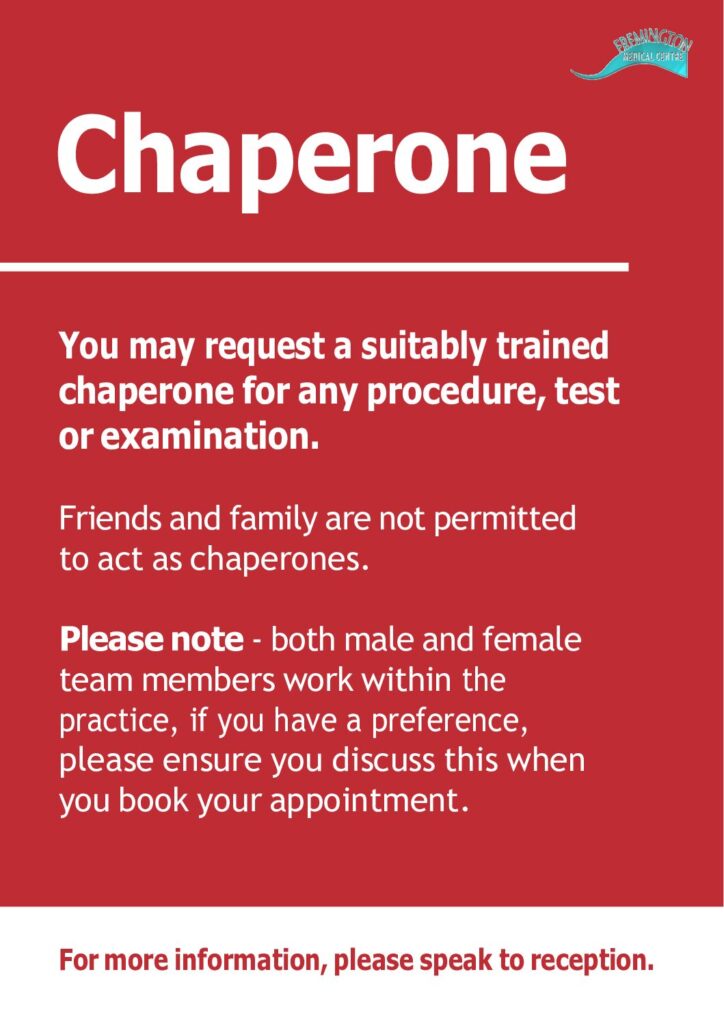Chaperones
Introduction
At this organisation, all patients will routinely be offered a chaperone, ideally at the time of booking an appointment. It is a requirement that, when necessary, chaperones are provided to protect and safeguard both patients and clinicians during intimate examinations or procedures. This policy adheres to the guidance detailed in CQC GP mythbuster 15: Chaperones.
To raise awareness, the chaperone policy will be clearly advertised. At this organisation, a chaperone poster is displayed in the waiting area, all clinical areas and on the organisation website.
In accordance with the Equality Act 2010, we have considered how provisions within this policy might impact on different groups and individuals. This document and any procedures contained within it are non-contractual, which means they may be modified or withdrawn at any time. They apply to all employees and contractors working for the organisation.
At this organisation, it is policy that any member of the team can act as a chaperone and those that have a basic DBS Check as minimum. However, they must have undertaken chaperone training as detailed in CQC GP mythbuster 15. Additionally, all staff must complete chaperone awareness training which covers the role of the chaperone.
General guidance
The General Medical Council (GMC) Intimate examinations and chaperones guidance explains that the patient should be given the option of having an impartial observer (a chaperone) present whenever possible. As per the GMC guidance, relatives or friends of the patient are not considered to be an impartial observer so would not usually be a suitable chaperone but staff at this organisation should comply with a reasonable request to have such a person present in addition to the chaperone. The GMC guidance also provides detailed guidance on what the clinician should do before and during the examination, including adhering to the GMC Decision making and consent guidance.
When a chaperone is present, the details of the chaperone must be recorded in the patient’s clinical record.
Role and expectations of a chaperone
Staff at this organisation acting as a chaperone are to adhere to the guidance referenced at 2.2. CQC GP mythbuster 15: Chaperones advises that for most patients and procedures, respect, explanation, consent and privacy are all that are needed. These take precedence over the need for a chaperone. A chaperone does not remove the need for adequate explanation and courtesy. Neither can a chaperone provide full assurance that the procedure or examination is conducted appropriately.
When a chaperone is unavailable
The GMC further advises that if either the clinician or the patient does not want the examination to go ahead without a chaperone present, or if either is uncomfortable with the choice of chaperone, the clinician may offer to delay the examination until a later date when a suitable chaperone will be available providing the delay would not adversely affect the patient’s health.
When a patient refuses a chaperone
If the clinician does not want to proceed with the examination without a chaperone but the patient has refused a chaperone, the clinician must clearly explain why they want a chaperone to be present. The GMC states that ultimately the patient’s clinical needs must take precedence. The clinician may wish to consider referring the patient to a colleague who would be willing to examine them without a chaperone providing a delay would not adversely affect the patient’s health.
Any discussion about chaperones and the outcome should be recorded in the patient’s medical record, and in particular:
- Who the chaperone was
- Their title
- That the offer was made and declined
Disclosure and Barring Service (DBS) check
Clinical staff who undertake a chaperone role at this organisation will already have a DBS check. CQC GP mythbuster 15: Chaperones states that non-clinical staff who carry out chaperone duties may need a DBS check. This is due to the nature of chaperoning duties and the level of patient contact. Should the organisation decide not to carry out a DBS check for any non-clinical staff, then a clear rationale for this decision must be given including an appropriate risk assessment.
Using chaperones during a video consultation
While it is widely accepted that many intimate examinations will not be suitable for a video consultation, should such a consultation be agreed, staff at this organisation are to adhere to the guidance detailed in CQC GP mythbuster 15.
If a chaperone was not requested at the time of booking the appointment, the clinician will offer the patient a chaperone explaining the requirements:
- Contact reception and request a chaperone
- Use the Chaperone template and Record in the individual’s healthcare record that a chaperone is present and identify them
- The chaperone should be introduced to the patient
- The chaperone should assist as required but maintain a position so that they are able to witness the procedure/examination (usually at the head end)
- The chaperone should adhere to their role at all times
- Post procedure or examination, the chaperone should ensure they annotate in the patient’s healthcare record using the system one chaperone template, that they were present during the examination and there were no issues observed
- The clinician will annotate in the individual’s healthcare record the full details of the procedure as per current medical records policyexplanation and courtesy. Neither can a chaperone provide full assurance that the procedure or examination is conducted appropriately.
